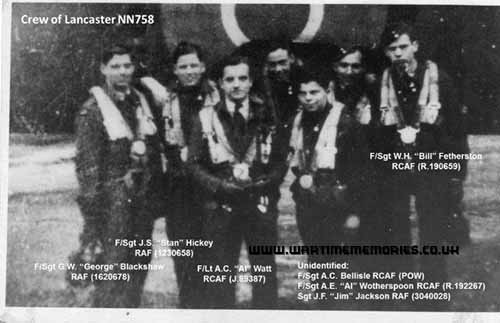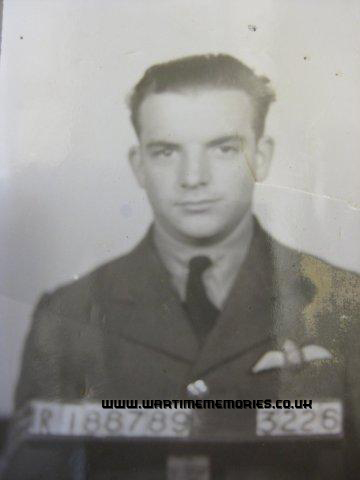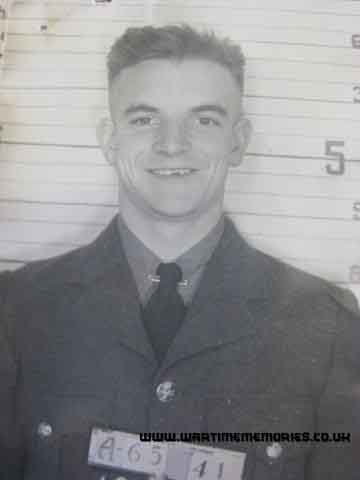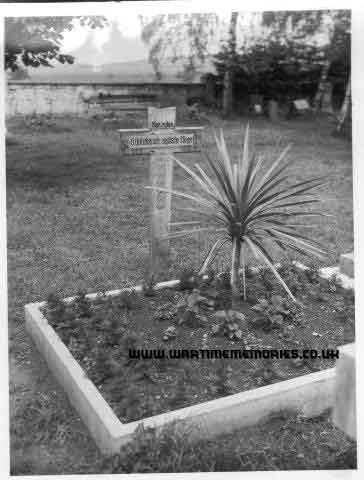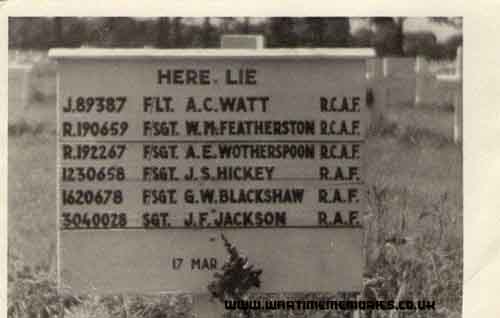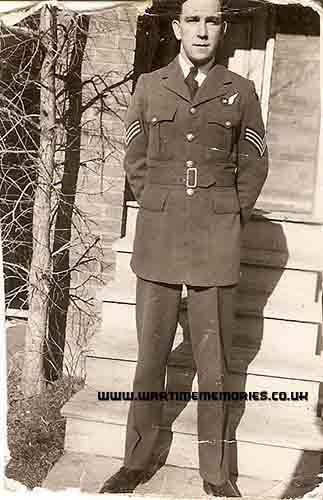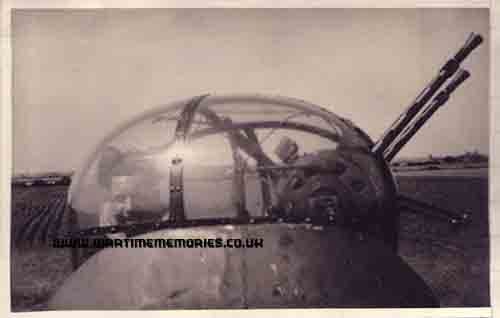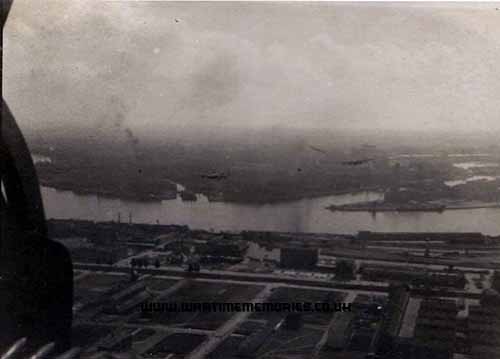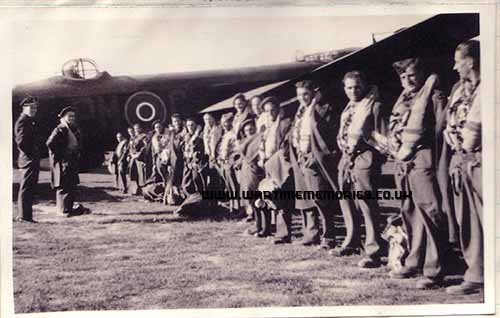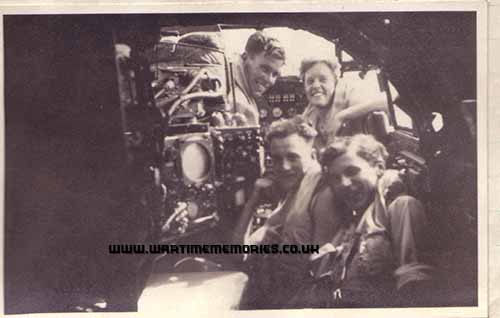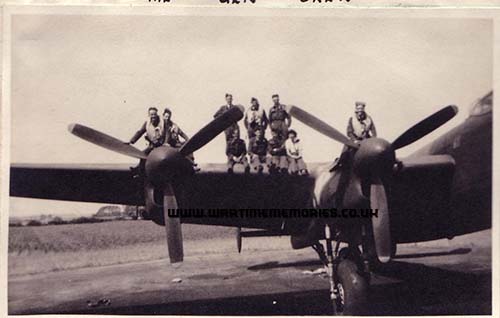F/O. Bernard Graham "B.G." McDonald 103 Squadron
That Damn Stuttgart Again
In the briefing room that evening we were startled to see the red route ribbons on the big wall map pointing to Stuttgart, with the same turning points as for the raids on the 24th and 25th. I turned to Vic and Chuck and said, "The stupid bastards haven't changed the ribbons for tonight's target."
Even when Wing Commander R. St. John, DFC stepped up onto the stage, the ribbons hadn't been touched. I was thinking: "What the hell is going on?" when he announced in his usual hearty manner, "Gentlemen, target for tonight is Stuttgart."
Following his brief remarks emphasizing the importance of Stuttgart and the necessity to hit it again, the Intelligence Officer (a non-flying type) took over. In response to loud shouts of "Change the bloody ribbons!" he gave us a song-and-dance story to the effect that the Germans definitely would not suspect that we would fly the same route for three successive raids. His remarks were greeted by a chorus of groans, moans, curses, raspberries, and boos. One WAG demanded to know if Bomber Harris (Air Chief Marshal, Bomber Command) was going along with us to test his theory.
After stowing our parachutes, lunch and other gear in our B-Baker Lancaster, we loitered around outside the kite making small talk. I'm sure each member of the crew was silently visualizing the perils that awaited us in the skies over Germany; radar-predicted batteries of searchlights and flak guns, as well as the deadly night fighters. We knew the Gerries weren't about to allow 800 RAF/RCAF bombers to penetrate deep into Germany without putting up a hell of a fight. Although I had 100% confidence in the ability and steadfastness of our crew, I also was aware of the old saying: "If you are in the wrong place at the wrong time, there's nothing you can do about it."
We maintained a sharp watch from the minute of take-off. Every man, not otherwise occupied, kept a constantly roving eye for other aircraft; enemy or "one-of-ours." A collision in the dark with a friendly aircraft is just as deadly as being shot down by a Gerry fighter. My eyes were glued to the radar set and I would not change position until the target area, when I would stand with my head in the astrodome bubble acting as lookout for enemy fighters.
The Gerrys fought us all the way from the enemy coast. Contrary to Bomber Harris and his harebrained prediction that the Germans would be baffled by his route tactics, they appeared to have expected our visit. Searchlights, flak guns and fighters were extremely active. Flak was very heavy in many areas, searchlights coning hapless bombers and fighters infiltrating the bomber stream.
While all this was taking place, my job was to warn Art and Chuck of any suspicious blips on my radar screen. I don't recall how many times we gave evasive action calls to J.O. In response to "Corkscrew port" or "Corkscrew starboard" his instantaneous reaction treated us to bone-jarring corkscrews that compelled us to hang on for dear life.
It was difficult to avoid being pinned against the roof or smashed against my equipment during J.O's violent rolling dives and climbs as he executed the corkscrew manoeuvre in masterly fashion. I hooked my knees under the wireless table, gritted my teeth and hung on!
As we approached the target area, the congestion of air traffic was so great that my radar was overwhelmed, so I left my position and stood under the astrodome with my head in the perspex bubble to watch for German fighters. Starting our run-in over the city, the scene was hard to describe. The sky was full of bursting shells, searchlights, flak coming up and bombs going down, along with clusters of incendiary sticks. There were cascades of brilliantly coloured markers, bomb bursts and fires raging on the ground. Added to the fireworks display were the seven million candlepower photo flashes automatically triggered as each bomb load landed. If you've never experienced the sight of a night attack on a major German city, it's incredible!
We were at about 24,000 ft. with bomb doors open when Vic calmly called out course corrections as he prepared to release our bombs and incendiaries. I was holding my breath when, suddenly, a tremendous thump shook the entire aircraft, as if a flak shell had hit our 4,000 lb. "cookie" right under my feet. At the same instant, I saw the whole starboard fin and rudder, the elevator and horizontal stabilizer crumple up and disappear in the slipstream. The whole assembly blew off so close to the rear turret that my first thought was "There goes poor Chuck." B-Baker flipped over and headed for the deck in a screaming dive. No doubt in my mind that this was the end, CHOP-CHOP!, but no real panic, I was simply resigned to my fate.
The popular notion that your whole life flashes before your eyes in the instant before death is a lot of bull. My only thought was of my parents receiving a telegram with the bad news. While the rest of us were quietly waiting for the big bang, J.O. and Paddy were fighting like mad to pull the kite out of the dive.
Unbelievably, they managed to straighten it out at about 10,000 ft. as J.O. shouted "Prepare to bale out!" A gallant gesture, as there was no way he could escape. Vic had already jettisoned the bombs. Chuck, miraculously alive, called on the intercom to say his turret door was stuck on the beam and he was unable to reach his parachute. We decided that, "No way were we going to abandon J.O. and Chuck."
J.O., with both feet and full body force on the left rudder pedal, was struggling with the controls and said he couldn't hold out much longer. I went forward and, crouching in front of his foot controls, I gripped the left pedal and pulled with all my strength to take off some of the pressure on his legs. It worked quite well, so Paddy and Vic also took turns. However, it was exhausting work in the cramped position, so Paddy fetched the dinghy rope and rigged the pedal to a stanchion. Happily, J.O. was able to carry on with much less exertion and, meanwhile, Chuck was able to straighten his turret by means of the emergency hand crank.
Half an hour later, we were still alive but in a very precarious situation, especially when Paddy announced that we were losing petrol. My equipment was undamaged so I kept watch on the radar. At the same time, I searched frequencies on the radio receiver to pickup Gerry controllers issuing instructions to night fighters patrolling the defensive boxes through which we were flying.
Unable to take evasive action, we were sitting ducks if enemy fighters were to attack. At this stage of the game I announced on the intercom: "I don't know about you guys but I don't intend to die on an empty stomach. I'm going to drink my coffee and eat my sandwiches right now." I proceeded to do just that by pouring myself a cup of coffee and munching on a sandwich.
While J.O. steered the course for base that Jack plotted with little regard for the designated return route, we assessed the damage. The complete starboard tail assembly blown off, about six feet torn off the starboard wing, bomb doors ripped off, landing gear smashed, hydraulics damaged and a petrol leak. Both gunners were unable to rotate their turrets except by hand crank. Our chances of surviving a four-hour journey through enemy territory were slim. We knew what happened to badly damaged stragglers limping back to England. Chop-Chop!
Fortunately, it was a moonless night with cloudy patches and low visibility, giving us some hope. Suddenly, I picked up a German controller, loud and clear, obviously having caught us on his radar screen and now directing the night fighters to our position. I tuned the #1154 radio transmitter to the German's frequency and activated the starboard engine microphone to jam his instructions. Both Chuck and Art reported parachute flares descending from above and to our rear as the fighters searched for us. This "cat-and-mouse" game continued intermittently as we passed through successive defensive boxes.
Long before approaching the Allied lines in France, my thermos was empty, sandwiches and chocolate bar eaten. We gave a collective sigh of relief when Jack announced that we were over the British/Canadian sector of the battlefield below. It was short-lived relief, however, when flak started to burst uncomfortably close. We couldn't blame the ack-ack gunners, they had no way of knowing we were "one-of-theirs."
Soon after passing through the "friendly" flak, we faced another problem; our diminishing supply of fuel. Paddy said it looked as if we'd have to ditch in the North Sea. At the midway mark of the water, dawn was breaking and we could see the whitecaps below. I commenced emergency procedures, switching on IFF (Identification Friend or Foe) and transmitting SOS signals. Prospects of surviving a ditching in the choppy sea were not good, so we decided to try for a crash landing at an airfield near London. I clamped the wireless key to the emergency frequency in case we suddenly had to ditch.
We agreed that those of us not essential for the crash-landing procedure would bale out over London. J.O. needed Jack to direct him to the nearest airfield and Paddy's role was crucial helping him with the throttles. The rest of us were excess baggage; if the three of them were killed in the crash-landing, the ones who baled out would live to fight another day.
Over the English coast we ran into a stretch of cloud with nil visibility. As if we needed further complications, our earphones picked up the ominous "beeps" of a balloon barrage area. Emerging unscathed from the cloud, we were pleased to see a clear sky and the suburbs of London.
I took charge of the jumping and Vic was the first to go. He crouched at the open escape hatch in the belly of the kite and hesitated as if he didn't like what he saw below. I grabbed hold of two stanchions, placed my feet squarely on his backside and gave a mighty heave. He released his grip at the same time and shot out of the aircraft like a human cannonball.
I turned to see Art shedding his bulky gunner's suit and buckling his parachute harness over his battledress. It looked as if his quick-release unit wasn't working properly, so I insisted that he rebuckle the four metal inserts. I made him repeat the process twice, with no noticeable improvement. No time to fool around... especially when he said, "Oh, yeah, a jeep ran over my harness just before we boarded the aircraft." He was about to jump when I noticed his helmet was plugged into a nearby intercom socket and the wire leads twisted. No time to unbuckle his helmet, so I whipped out my hunting knife and slashed off the wires, close to his ears. I'll never forget the look of shock in his eyes.
We were standing in the flight engineer position and looking down at the escape hatch about ten feet below and to the left of the steps. Completely ignoring the steps, Art dived headfirst straight through the open hatch. Had he misjudged his dive, he'd have cracked open his head.
Chuck moved up from the rear turret and prepared to jump. Halfway down the steps to the escape hatch, he turned and started to climb back to where I was standing. I suddenly remembered that he had vowed, several times, never to bale out, preferring to take his chances staying aboard. I blocked his way with my body and tried to force him back but the son-of-a-gun was too strong for me. I shoved him aside and shouted in his ear, "Okay, Chuck, if you don't want to jump, then get out of my way because I do." I had always wanted the opportunity to bale out and I didn't intend to miss this chance.
We were at 6,000 ft. and it was 0600 hours by my watch when I dropped through the hatch of B-Baker, hugging the chute to my chest with my left arm and gripping the D-Ring release with my right hand. I had no intention of opening the chute until I had some idea of what lay below. I didn't relish the thought of landing on the slope of a cathedral roof and sliding off. Also, I was hoping to land near a pub. Although opening hour was some three hours away, I thought I could talk the proprietor into drawing a pint for me in view of the circumstances.
With these pleasant thoughts going through my mind, I was struck by the absolute silence compared to the noisy aircraft, and the great sense of freedom as I floated face down. Realizing the impossibility of identifying a pub from the air, and with the city coming up fast, I pulled the D-Ring. The chute whipped past my face, tore off the left earphone unit of my helmet and opened with a snap. Instead of dropping the D-Ring, I shoved it inside my battledress jacket as a souvenir. Today, it is mounted on a plaque and hanging in my son's Ottawa office.
A surprisingly strong wind blew me towards what looked like a flock of sheep. Sheep in a London suburb??? It didn't make sense. As I floated closer, I saw that it was a cemetery full of white gravestones. The city street was deserted except for one man riding a bicycle with a lunch pail on the handlebars. A couple of blasts on my whistle got his attention. I felt sure he would summon help in case I was injured on landing.
Drifting quite fast into the cemetery, I covered my head with my arms to cushion possible contact with a granite gravestone. I needn't have bothered because the next thing I knew, I was swinging like a pendulum under the overhang of the tallest tree in all of England. I was about 40 feet or so off the ground with my silk caught in the upper branches , no possibility of climbing into the tree and far too high to risk breaking my legs or neck by releasing my harness.
Confident that my friend on the bicycle would send help, I dug out my cigarettes and lit one. The harness straps were pressing so hard against my temples that it was uncomfortable to look down. A few minutes later, I heard a great shout from below: "Surrender or I'll Fire!"
Pulling one strap aside, I looked down to see an elderly man in Home Guard uniform pointing a Lee-Enfield rifle at me and repeating his command to surrender, obviously anxious to put a bullet into what he thought to be a German airman. I roared back at him "Put down that effing rifle or I'll climb down from this effing tree and wrap it around your effing neck!" I had to laugh when he exclaimed, "OH! A Bloody Can-ide-dee-un!" He lowered the rifle and enquired, "I say, Canada, are you wounded?" Assuring him that I was fine, he replied that he would get help "roight awaye"... and off he went.
Next to arrive was an ambulance and both attendants wanted to know if I was wounded. Five minutes later, a police car joined the group and an officer asked if I was wounded. He also reported that Vic and Art had been picked up and were at the Battersea police station. He had no word on the fate of J.O., Jack, Paddy and Chuck. I was told that I had landed in Battersea Cemetery (Morden, Surrey) and that a fire truck was en route to rescue me.
The fire truck arrived around 0645 hours. By this time I didn't bother to look down when communicating with the men in the cemetery. With the harness straps pressing against my temples, I kept my head rigid, eyes straight ahead and shouted my answers. You guessed it! One of the firemen called out: "Are you wounded, Canada?" I shouted back: "No. I'm not wounded but my nuts are killing me and I need to take a leak." Great peals of laughter greeted this announcement. Loosening one strap, I peered down and was astonished to see a large group of people. Among the onlookers were housewives in aprons, elderly men and women, adolescents and little children, all laughing like mad! I was quite embarrassed.
The hydraulic ladder was activated but missed me by at least twelve feet. When I suggested that I release my harness and attempt to drop onto the top of the ladder, the firefighters wisely persuaded me to be patient. They promised to order a longer ladder from Croyden amid encouraging words: "Hang in there, Canada, we'll get you down."
It was 0730 hours before the Croydon unit arrived and extended a huge ladder that placed a large platform right under my feet. The firefighter on the platform asked if I wanted him to retrieve my silk parachute tangled higher up in the branches. I said, "Hell, no, keep it with my compliments and have your wife make herself a pair of knickers." He insisted upon buckling a sturdy safety belt around my waist and hooking it to a rail before assisting my descent.
When I reached the last few steps, a husky firefighter hoisted me onto his shoulders and someone handed me a lighted cigarette and a mug of tea. The big guy paraded me around the cemetery while everyone clapped, amid shouts of "God bless you, Canada. Give 'em hell, Canada." What a wonderful people!
I was taken by police car to the Battersea station where I joined Vic and Art. We were told that J.O., Jack, Paddy and Chuck had safely crash-landed at the White Waltham airfield. The police were very good to us. Instructions came through to take us to a balloon barrage unit for the return to 103 Squadron.
Before detailing Vic and Art's experiences, I should mention Vic was barefoot. His fleece-lined flying boots had been ripped off his feet when he jumped into the slipstream. Art and I had worn laced leather shoes and they were still on our feet.
The commanding officer of the balloon barrage site was waiting at the entrance gate when we arrived in the police car. A veteran of World War I, with two rows of ribbons on his battledress jacket, he gave us a hearty welcome, shaking hands with each of us. Noticing Vic's bare feet, he turned his back, bent his knees and said, "Jump on; I'll give you a lift." Vic leaped onto his back and the CO piggybacked him all the way to the administration building. Whoever said English Army officers were stuffy?
On arrival at the admin building, Art and Vic opted for a good breakfast (and a pair of shoes for Vic) and they were taken away by the Orderly Sergeant. I declined breakfast but accepted the CO's invitation to join him in his office to discuss transportation back to Elsham Wolds.
I have forgotten his name and rank although I do remember calling him Colonel and he addressed me as Mr. McDonald, as my rank of WO1 warranted. He motioned me to a chair, dug a key out of his pocket, opened the top drawer of the filing cabinet and produced a bottle of Johnny Walker and two glasses. He poured two man-sized drinks, handed one to me and said, "Cheers!" Following a brief chat and a second powerful drink, we got down to business.
The CO said, "I'm sure you're anxious to get back to your Squadron as soon as possible. I can lay on a light aircraft or send you back by motor transport." Here I was, a short distance from my favorite pub and the city where I spent all my leaves. No way was I going to leave at once. I wasn't that anxious to rush back.
I pretended to consider the offer and, after a suitable length of time, I replied: "If you don't mind, sir, I prefer to go by rail. All I require is a travel warrant. I'll take charge of the two sergeants and we'll make our own way back to Elsham Wolds. He thought that to be a good idea, called for a corporal and ordered the necessary arrangements. By this time, about 0930 hours with six ounces of good Scotch on an empty stomach, I'm feeling quite mellow and could have cared less if I never got back to the Squadron. I said, "Colonel, I have a girl friend in London and I'd like to see her before catching the train. Would you mind letting us have a vehicle and a driver to take us into town?" The old boy looked at me, burst out laughing and said, "McDonald, my staff car will take you anywhere you want to go, so long as my driver is back here by 1200 hours."
At 10:00 hours we bade our host good-bye and thanked him for his great hospitality. With my best salute to a fine officer and gentleman, we were on our way, in the colonel's staff car. First stop at Cartwright Gardens. We trooped into the reception room where Miss Kelly was at the desk. She was startled to see me, saying, "What in the world are you doing here, B.G.? You just left on Sunday evening." I said, "Yes, but I had to bale out over Battersea Cemetery early this morning." Her answer was, "Come on, B.G., none of your usual blarney." The only way to convince her was to reach inside my battledress jacket, hand over my Smith & Wesson pistol and ask her to place it in the safe for me.
Realizing that I wasn't kidding, she became quite excited. She gave Vic and Art the key to a double room and said: "You come with me, B.G." I followed her to her office where she rummaged around in a cupboard and came up with a bottle of Scotch, saying: "I've been saving this to celebrate VE Day " but we're going to have a drink right now." She poured a large drink for me and a small one for herself. We touched glasses and said, "Cheers!"
By 11:00 hours, with a couple of quid borrowed from Miss Kelly, I was on my way to the Euston Tavern where "Uncle" was behind the bar with his back turned. I rapped on the counter and called out: "I say, old chap, do you have draft Bass on tap today?" He quickly turned to deal with what he thought to be an impertinent customer. He almost fell over when he recognized me. He had wished me luck on Sunday evening and "Auntie" had given me a big hug when she said good-bye. The lovable old girl treated me like a son. She used to say: "B.G., you're a mother's heartbreak."
When I told "Uncle" that I had jumped over the city, he said, "You're not drinking beer this morning." He darted into the basement and emerged with two bottles of Vat 69. "Auntie" joined the happy reunion along with Sheilagh and Fred. The drinks were coming from all directions and I still hadn't eaten since the sandwiches over Germany. While I was in the pub, three Canadians from another RAF squadron arrived in London on leave and checked into Cartwright Gardens. One of them said to Miss Kelly: "I'm afraid we have some bad news for you. Our old friend, B.G. McDonald, got the chop last night." Miss Kelly laughed and replied, "Well, if B.G. got the chop, it must have happened within the last hour or so. The last I saw of him, he was on his way to the Euston." Amazing how the wartime grapevine worked. They dropped their bags and rushed to the pub, just in time to have one drink with me before I flaked out from too much whiskey and too little food.
In the afternoon, we went to the rail station and witnessed a scene of organized bedlam. Thousands of London children were being evacuated to the country because of the ever-increasing danger from German buzz bombs (V1 rockets) that were hitting the city in large numbers.
I turned to Vic and said, "To hell with this, we're staying until this exodus peters out. We wouldn't want to take seats away from little kids, would we?" Both he and Art looked at me as if to say, "Here we go again, B.G. pulling a fast one on the RAF, hope he doesn't drag us into a charge of AWOL or worse." I knew what they were thinking and I assured them I would assume full responsibility for any repercussions.
I went back to the Euston to ponder our financial situation. It wasn't good. We had French francs and German marks in our escape kits, but no English money. Before going on a bombing raid, all participating aircrew had to place their wallets, notes, loose change, photos etc. in individual little cloth bags. They were name-tagged and held by the Intelligence staff until the safe return (or not) of the owners.
We weren't allowed to carry anything over enemy territory that might identify our Squadron or its location, in case of capture and interrogation by German intelligence people. The French francs and German marks were for use in France or Germany while trying to evade capture after baling out. If I ever had to bale out over France, my chances of making my way back to England would have been good as I did speak some Quebec French. Escaping from Germany would have been a different story. It was only later when we learned that the Lancaster had a nasty reputation for escaping crews. Survival rate of the Lancaster was 11 % compared to 29% for the Halifax.
When I stepped up to the bar, Fred placed a draft Bass on the counter and said, "B.G., you don't have any money, do you?" I laughed and explained the reason and said I'd have to be heading back to Elsham Wolds, even though I'd prefer to stay in London for a couple of days.
Without saying a word, he opened the safe and handed me twenty-five pounds. That was a lot of spending money in 1944. I protested, saying, "Fred, I can't take it. Do you realize I could be killed within a few days of returning to Elsham Wolds and you'd be out twenty-five quid?" He refused to listen and wouldn't accept my offer to sign an I.O.U. I hasten to add that I repaid the loan shortly after returning to my squadron.
We rebooked our rooms at Cartwright Gardens and I loaned Art and Vic enough money for movies and other sundry pleasures. Fortunately, they neither drank nor smoked, otherwise, my borrowed twenty-five quid wouldn't have lasted very long.
We stayed in London for another two days , after which I was without funds and my two crewmates were becoming more apprehensive of a possible cool reception at Elsham Wolds. I couldn't blame them for being worried. It must be remembered that I hadn't communicated with the Squadron by phone, wire or any other method since baling out.
On Friday morning, I bade "au revoir" to my London friends, shaking hands with the men and kissing all the women, including Nellie, my favourite chambermaid. At the rail station there was no chance of getting on board due to crowds of adults. By this time, I knew we had to leave London before serious trouble caught up with us. A few words in the ear of a railway official and he pushed through the crowd, shouting, "Make way for these bomber boys. They must get back to their squadron." He secured seats in a first class carriage for us and we were on our way.
Barnetby was the closest rail station to 103 Squadron and, as the train ground to a halt, guess who was pacing up and down the platform? You guessed it! Flight Lieutenant J.O. Birch and he was furious! As we disembarked, I reminded Vic and Art: "Not a word except "hello, I'll do the talking." They readily agreed, not relishing the thought of having to explain.
Poor old J.O. was white with rage. So damn mad he could hardly talk. Finally, he snarled: "Where in hell have you been?" He turned to the other two and said, "Don't worry, you're not to blame." It appeared that I wasn't included in his act of amnesty. All he said to me was, "Wait till the CO gets you!"
We climbed into an RAF van for the ride to #103. On arrival, J.O. was all for presenting me to the Commanding Officer right away. However, I insisted upon going to my hut to get cleaned up. I deliberately took my time changing my shirt and fussing about, while J.O. stood watching and absolutely fuming. Dead silence prevailed, as we had not spoken since leaving the van. Finally, after testing his patience to the limit, I jumped on my bike and pedalled very, very slowly towards the flight shacks, with J.O. trotting along beside me.
At the flight shacks, we spotted the CO standing outside and chatting with a group of aircrew officers, all of whom looked up as I parked my bike in a nearby rack. Conversation ceased as J.O. and I walked over to the group, I guess everyone figured the flak would be heavy when Wing Commander St. John tore a double strip off my hide.
I stepped in front of the Wing Commander, clicked my heels together, saluted and said: "Good morning, sir!" Much to my surprise, he extended his hand and boomed: "Welcome back to the Squadron, McDonald." I replied: "Very glad to be back, sir." He asked how I liked baling out and, after a few words, shook hands again and turned away.
After taking several steps, he turned back and said, "I say, McDonald, what took you three days to travel from London to Elsham Wolds?" My reply was, "I took my survivor's leave, sir." Peering at me with a puzzled look, he asked, "What do you mean by survivor's leave?"
Looking him straight in the eye, I replied, "It is my understanding, sir, that the unwritten law of the Royal Air Force says that if an airman saves his life by baling out or ditching in the sea, he is entitled to three days leave. I took my three days leave in London, sir." He looked a bit stunned for a few seconds then laughed and exclaimed, "By Gad, McDonald, I've been in the RAF for many years and I've never heard that one."





